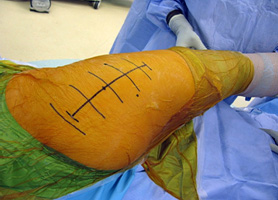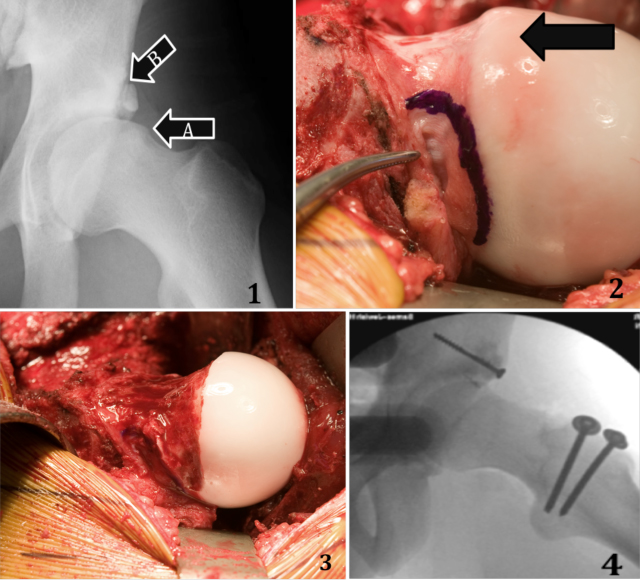Open hip dislocation refers to a surgical procedure in which the ball-and-socket hip joint is surgically dislocated so that the natural hip joint can be repaired. Open hip dislocation can be an extremely effective way to correct complex hip disorders while preserving your natural hip joint.

Photo of a right hip showing lines for an incision along the outside of the hip.
Why Would an Open Hip Dislocation be Performed?
An open hip dislocation is most commonly used to treat younger patients with a relatively healthy hip but with a specific problem that requires open correction. This procedure is most effective for major hip deformities that may not be adequately corrected with hip arthroscopy. Hip disorders treated with surgical dislocation include:
- Complex femoroacetabular impingement (FAI) deformities
- Major structural abnormalities of the hip joint, such as
- A deformed femoral head as seen in Perthes Disease
- Slipped capital femoral epiphysis (SCFE)
- Articular cartilage defects (joint surface defects)
- Post-traumatic hip deformities
- Other conditions (tumors and fractures)
Candidates for open dislocation of the hip must have a relatively healthy hip with a problem that can be surgically corrected. Examples of such surgical corrections include:
- Treating/grafting surface cartilage problems
- Repairing the acetabular labrum (rim of cartilage around the hip socket)
- Reshaping the rim of the hip socket
- Correcting the shape of the ball (femoral head) and/or top of the femur bone
Open hip dislocation may help certain patients with structural problems of the hip prevent or at least delay the development of osteoarthritis.
The Procedure
Surgery is conducted under general anesthesia. A small section of the thigh bone (called the greater trochanter) is cut in a procedure called a trochanteric osteotomy. This bony fragment and the attached muscles can then be moved to provide access to the hip joint. This allows the surgeon to gently rotate and expose the entire hip joint.
The ball-shaped femoral head of the thigh bone can be dislocated out of the joint so that the hip socket (acetabulum) and top of the thigh bone (femoral head) can be inspected and, if necessary, repaired. The acetabular labrum and surface cartilage of the entire ball and socket can be visualized and treated.
During the procedure, the surgeon may need to smooth out areas of cartilage or bone (“debridement”). The labrum of the hip joint, which is a cartilage ring around the socket, may be repaired. In some cases, areas of bone may need to be shaved away from the socket and/or femur. If you are a candidate for open hip dislocation, Dr. Clohisy will explain to you the precise steps that will be taken in your surgery. Every patient is unique, and your procedure may differ from those of other people undergoing surgical dislocation.
Once the hip is repaired, the joint is relocated (restored) and the greater trochanter (portion of the thigh bone) is reattached using two or three fixation screws.
What Can I Expect from Open Hip Dislocation?
Open hip dislocation takes about an hour or two and is performed under general anesthesia. Most patients stay in the hospital for a few days. As with any major surgery, you can expect a degree of postsurgical discomfort, which can be controlled with pain medications. The trochanteric osteotomy (cutting of the thigh bone) takes about eight weeks to heal. During the first four weeks, you are allowed only to put partial weight on the surgical leg. You will be on a specific rehabilitation program designed to help you regain strength and mobility in the hip.
Most people who undergo open hip dislocation report that they are improved due to less pain and better activity level.

This is the side-view X-ray of the hip of a 17-year-old male with hip pain (1). The prominence of the femoral head-neck junction is indicated by arrow A. This is consistent with cam impingement. This patient also has a fracture of the acetabular rim as indicated by arrow B. At surgery, the femoral head exhibits the damaged articular cartilage (arrow) and prominence of the femoral head (2). The deformity is surgically corrected (3). The postoperative x-ray (4) demonstrates the correction of the impingement deformity. This patient had an excellent clinical result.
What are the Advantages of Open Hip Dislocation Over Other Treatments?
With an open hip dislocation, the surgeon has 360º access to the hip joint and the ability to visualize and treat many different conditions. An open hip dislocation allows complete visualization of the entire ball and socket and enables precise corrections of complex deformities. The exposure, precision and capacity to correct complex deformities is better than that provided by hip arthroscopy. This type of surgery is targeted at preserving the natural hip joint which is advantageous over hip replacement in many young patients. Of course, patients must be good candidates for hip preservation surgery. If arthritis is too advanced, total hip replacement may be required even in young patients.
Who is a Candidate for Open Dislocation of the Hip?
In general, open dislocation of the hip works best in younger, more active patients who have relatively healthy surface cartilage of the joint but a hip deformity that is producing pain and putting the hip at risk for progressive damage. The most common reasons for the procedure are: complex FAI, SCFE, Perthes Disease and post-traumatic disorders.
What Are the Risks and Benefits of Open Hip Dislocation?
There are risks inherent in any surgical procedure, and Dr. Clohisy and his staff will discuss those with you. Note that patients who undergo open hip dislocation will have a trochanteric osteotomy (surgical break of the greater trochanter) which requires about eight weeks to completely heal. Patients who undergo an open hip dislocation must anticipate a physical rehabilitation program to restore optimal use of the hip joint. Specific potential complications include, but are not limited to, nonunion, fracture, infection, nerve damage, blood vessel damage, blood clots, pain, stiffness, heterotopic bone formation, osteonecrosis
For most patients, open dislocation of the hip can provide pain relief, allow greater activity, and improve quality of life.
How Can I Find Out More?
The best way to learn about open dislocation of the hip and other treatments for hip disorders is to discuss your case with Dr. Clohisy. He will be able to advise you on the latest treatment options and how they relate to your individual case.